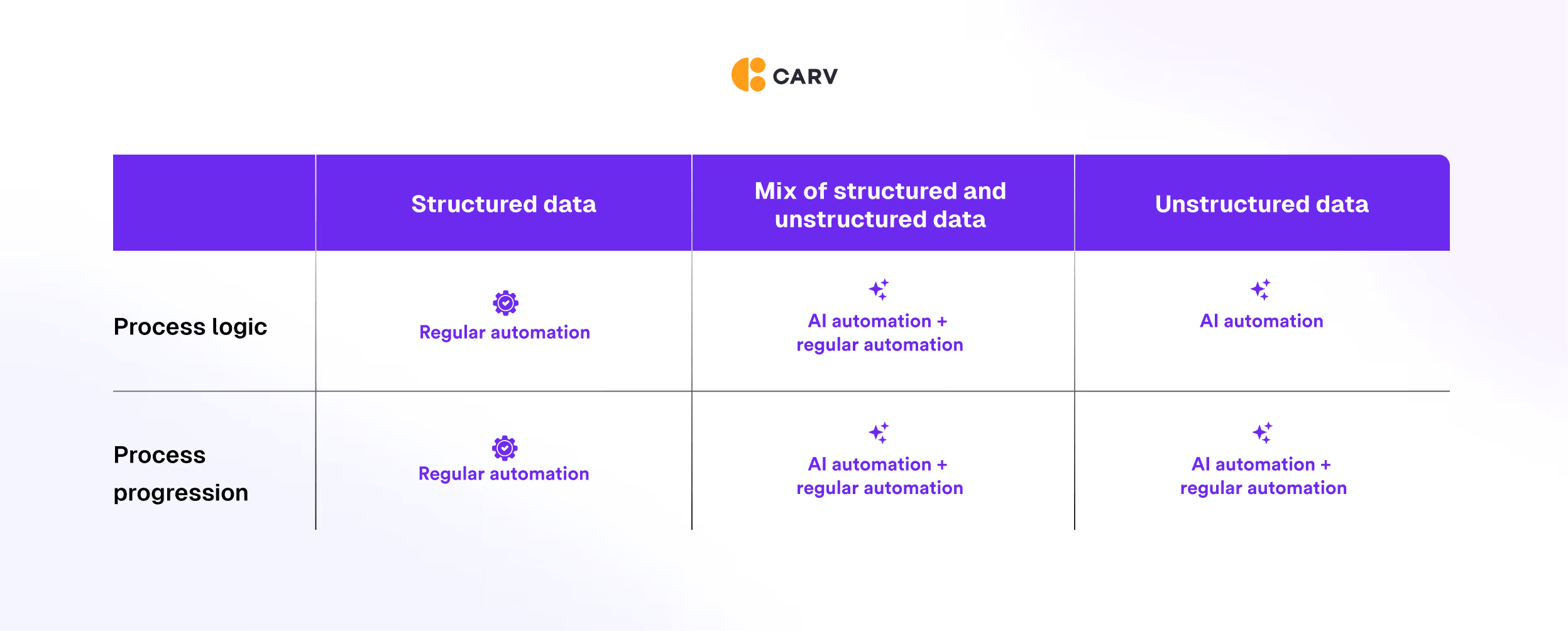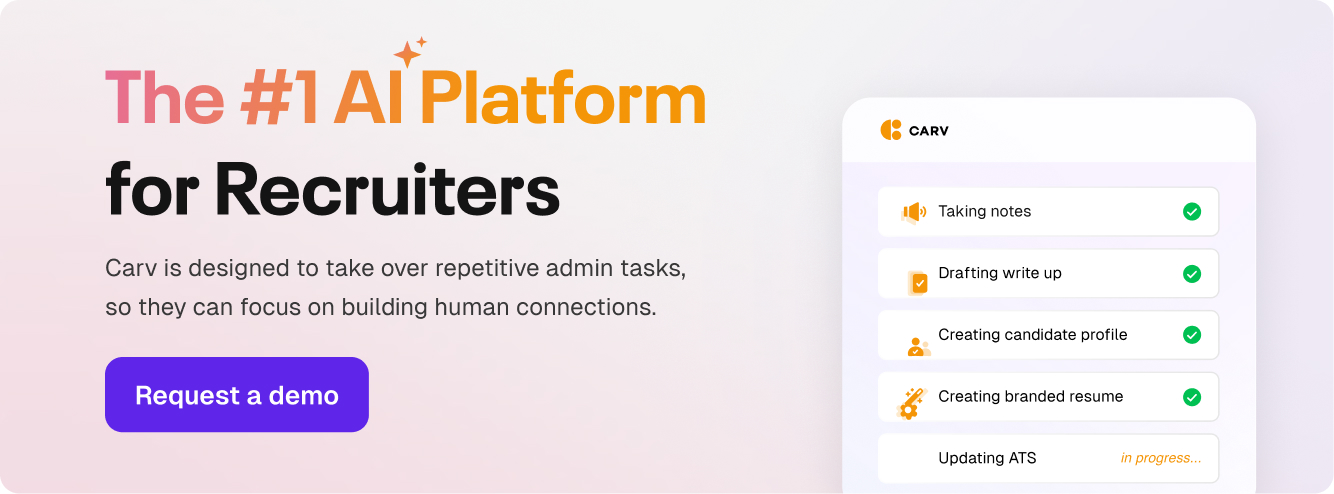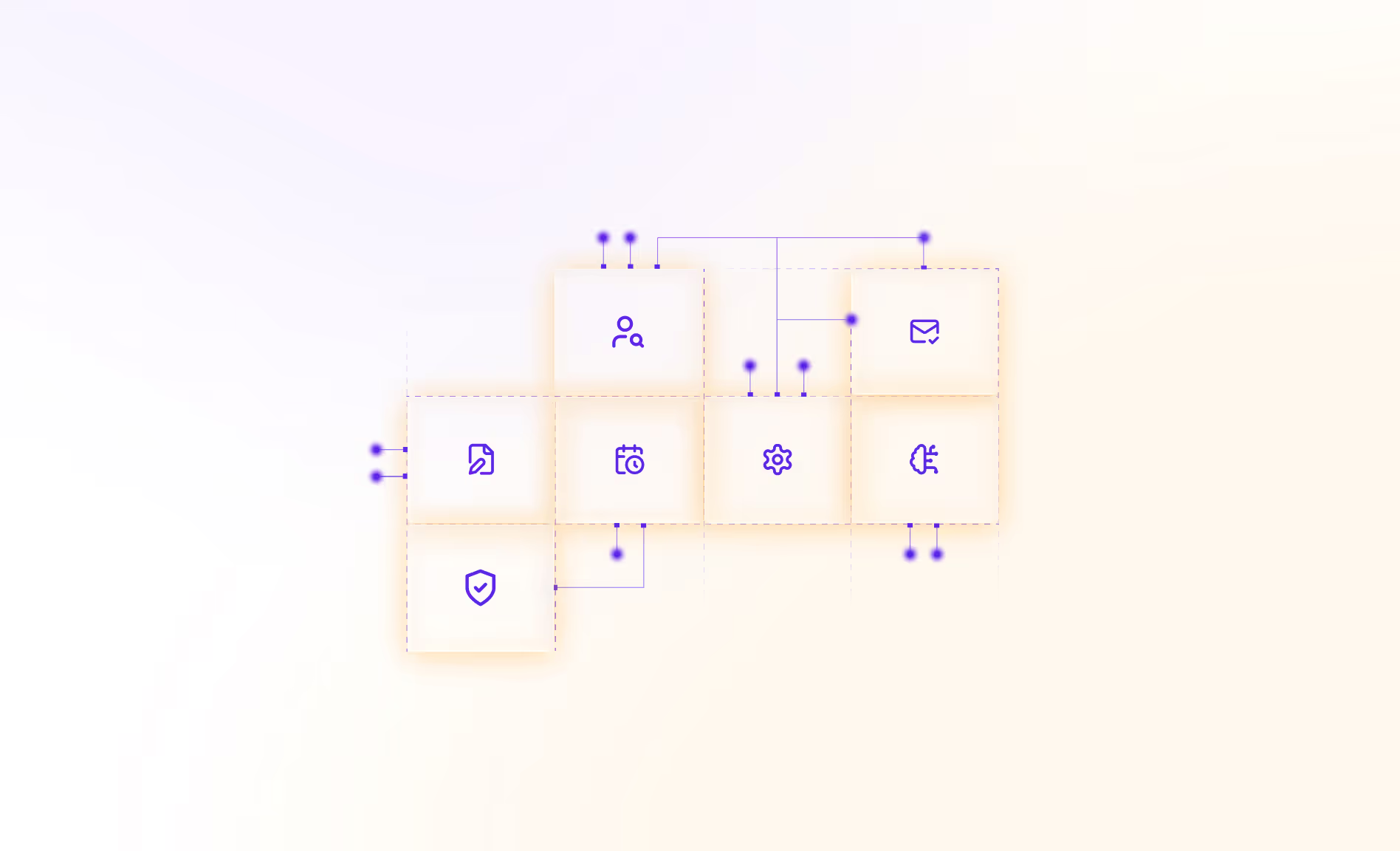The holistic perspective of full-cycle recruiting grants recruiters the power to prioritize tasks and drive results. However, it also comes with a hefty workload.
Beyond strategic decisions, full-cycle recruiters find themselves bogged down by low-impact, high-volume tasks.
These are the nuts and bolts that keep the end-to-end recruiting process running – drafting job descriptions and posting new job ads, screening CVs and cover letters, scheduling interviews and transferring data to the ATS, crafting candidate profiles, and so on.
While essential for a smooth hiring process, these activities don't impact bottom-line metrics, as they don’t directly translate to placements.
Traditionally, the solution has been to delegate such tasks to more junior recruitment team members, but this can slow things down and take some of the control away.
Automating the entire recruitment process offers an alternative path to effectiveness, but the fear of losing oversight lingers.
Enter AI-led recruitment.
In an AI-driven recruitment strategy, artificial intelligence automates the time-consuming, repetitive tasks, freeing up recruiters to focus on what truly matters: building strong relationships with candidates and clients.
So let's look at the practical aspects of AI-driven full-cycle recruitment to understand how to implement this approach, but also why the future of staffing lies in achieving synergy between human expertise and artificial intelligence.
Understanding the full-cycle recruiting process
Let's start with a definition to ensure we're all on the same page.
Full-cycle recruiting is a comprehensive approach to talent acquisition. In this approach, a single recruiter manages the entire hiring process, from start to finish.
360-degree recruiters, also known as full-cycle recruiters, orchestrate every aspect of the recruitment journey, juggling multiple responsibilities:
- Identifying hiring needs and creating compelling job descriptions.
- Posting job openings on relevant job boards or social media platforms.
- Sourcing and attracting qualified candidates for open positions.
- Screening resumes and conducting initial interviews to assess fit.
- Coordinating with hiring managers and facilitating final interviews.
- Negotiating offers and onboarding new hires to ensure a smooth transition.
This holistic approach gives full-cycle recruiters unparalleled visibility into all candidates, clients, and vacancies. They maintain complete control over process steps and stakeholder communications. This allows them to adapt quickly to changing priorities and market conditions.
However, while the comprehensive nature of full-cycle recruiting offers significant advantages, it also presents unique challenges.
Common challenges in full cycle recruiting
Here's a closer look at the common challenges that can hinder a recruiter's efficiency and effectiveness.
Time management
Recruiters often find themselves in a constant juggling act, trying to balance high-impact activities with necessary but time-consuming administrative tasks.
They juggle high-impact activities like strategic candidate sourcing and building relationships with clients alongside the necessary, but time-consuming, administrative tasks. Scheduling interviews, screening resumes, and updating Applicant Tracking Systems (ATS) can quickly consume valuable hours, leaving less time for the activities that drive results.
This struggle can lead to slow processes and a long time to hire, rushed interview processes, or superficial candidate assessments. Moreover, it can cause neglected relationships with potential revenue consequences, and increased stress for recruiters.
So the first and most important challenge to full cycle recruiters need to overcome is making more time for high-impact activities.

Administrative burden
Beyond basic scheduling, full-cycle recruiters spend a significant amount of time on purely administrative, low-impact tasks. These include data entry into Applicant Tracking Systems, drafting job descriptions, creating detailed candidate write-ups, and sending follow-up emails and status updates.
Such tasks, while necessary, often prevent recruiters from focusing on more strategic activities that directly impact hiring success.

Balancing quality and quantity
The pressure to meet placement targets can create a tension between speed and thoroughness. This leads to a reality where recruiters may use job description templates and overly polished job postings that create false expectations and mislead candidates.
Rushed screenings may lead to suboptimal candidate shortlists, while quality candidates may slip through the cracks, and inadequate time for in-depth candidate evaluation can result in a poor selection process.
Furthermore, hurried client interactions may weaken long-term relationships and impact client retention, and quick job offers and hiring decisions might lead to a poor quality of hire and potential early turnover.
Information overload
Managing vast amounts of data across multiple candidates and vacancies also presents significant challenges for recruiters managing all the stages of the recruitment process.
To give just some examples, recruiters may face difficulty in recalling specific details about potential candidates or positions, increased likelihood of overlooking suitable candidates, and challenges in spotting patterns or trends that could identify qualified candidates and inform hiring decisions.
Also, there’s always a risk of missing critical information during decision-making processes, and of cognitive fatigue from constant context-switching between different roles and candidates.
Scalability issues
As hiring demands increase, full-cycle recruiters often struggle to scale their efforts effectively.
This means that they deal with difficulty in maintaining personalized candidate experiences during high-volume hiring, increased likelihood of bottlenecks in the recruitment process, and challenges in simultaneously managing multiple complex hiring processes.
Next to these, there’s always the risk of overlooking ideal candidates in niche or specialized roles that require extra attention, and difficulty in adapting to sudden spikes in hiring needs without compromising quality.
Maintaining compliance and consistency
Finally, full-cycle recruiters must ensure compliance with various regulations and maintain consistency across all their activities.
They have to keep up with changing employment laws and regulations, mitigate risks through comprehensive background checks and reference checks, and maintain thorough documentation for all interactions and decisions.
These challenges highlight the complex nature of full-cycle recruiting and underscore the need for innovative solutions.
The need for innovation in the recruitment cycle
The current state of full-cycle recruiting demands a paradigm shift. Here's why innovation is crucial to the future success of this approach.
Empowering recruiters for strategic focus
There's a critical need to free recruiters from the shackles of low-impact tasks.
Innovation should empower them to focus on the strategic, high-value activities that truly drive results. This includes building strong relationships with the best candidates, fostering long-term talent pipelines, and acting as trusted advisors to clients.
Process automation beyond delegation
While delegating some tasks to assistants or interns has been a traditional solution, it's not always scalable and can introduce inconsistencies.
Technology offers a more robust and efficient alternative.
AI, in particular, holds immense potential to automate repetitive processes like resume screening, scheduling interviews, and generating data-driven candidate reports. This allows recruiters to reclaim their time and focus on the human touch that technology cannot replicate.

Control with enhanced visibility
A common concern regarding innovation is the fear of losing control. Recruiters need solutions that complement, not replace, their expertise.
The future lies in tools that enhance recruiters' oversight and visibility into the entire process. Imagine AI acting as an intelligent assistant, providing real-time data and insights to facilitate informed decision-making at every stage of the hiring journey.
Scaling efficiency without sacrificing quality
As businesses grow, the need for efficient and scalable recruitment solutions becomes ever more critical. Innovation should address the challenge of handling increased hiring volumes while maintaining the quality of hires.
AI-powered tools can streamline workflows, optimize candidate sourcing, and expedite the recruitment process without sacrificing the time and attention needed to identify the best talent.

Making use of the collected data
Recruiters collect vast amounts of data throughout the hiring process. The challenge lies in transforming this information into actionable insights.
Innovation is needed to equip recruiters with tools that leverage data analytics to identify top talent pools, predict hiring trends, and make data-driven decisions that optimize the entire recruitment cycle.
As you can see, AI presents a promising solution, offering the potential to automate routine tasks without compromising the recruiter's control or visibility.
Reimagining 360 recruiting with AI
We believe the future of full life cycle recruiting lies in embracing technologies that can unburden recruiters from admin tasks by fostering true recruiter-AI collaboration.
Here’s what this new reality looks like.
AI workmates work in perfect synergy with human recruiters
The prerequisite of AI-led recruitment is the addition of AI workmates or AI recruiters to the human resources or TA team.
Unlike human recruiters, AI assistants are able to perform tasks 24/7 without getting tired. They can work with any type of data - text, video, or audio, across tools and environments, and across languages.
This makes them ideal workmates for recruiters who manage the end-to-end recruitment process and need to remember not just the big lines but the smaller details about candidates, clients, or open roles.
%2520(1)%2520(1).avif)
AI workmates can be customized to perform certain tasks and can be embedded into specific workflows. For example, TA teams can choose to delegate only the screening phase to AI, and do the sourcing and interviewing themselves.
The whole point here is that an AI recruiter needs to work with and for a human recruiter, not vice-versa. So the human decides how much to delegate and where to keep control, and the AI assistant is there to execute tasks in the background, as prompted or programmed.
These virtual colleagues bring about numerous benefits for their human counterparts: Reduced stress from administrative overload, more time to focus on core recruitment activities, real-time insights and decision support.
We’ve detailed the concept of human-AI synergy in a previous article here, if you want to learn more.
Recruiter’s role changes from process admin to strategist
Imagine a future where the burden of administrative tasks lifts, freeing recruiters to focus on what they truly excel at – strategic talent acquisition.
%20(1).avif)
No more wrestling with draining, repetitive tasks. AI handles the heavy lifting, allowing recruiters to focus on high-value activities like:
- Talent pipelining: Sourcing candidates and nurturing top talent pools before a position even opens.
- Employer branding initiatives: Crafting a compelling employer brand that attracts the right candidates.
- Client relationship building: Developing strong, long-term partnerships with clients, understanding their unique needs and exceeding their expectations.
- Data-driven decision making: Leveraging AI insights to identify top talent, predict interview success, and optimize the recruitment process.
The future of AI-led 360 recruiting is about building relationships, not just filling positions.
With AI recruitment technology managing the administrative load, recruiters can dedicate time to fostering strong connections with both candidates and clients.
This shift empowers recruiters to become true talent partners, using their experience and judgment to make informed hiring decisions while leveraging AI's data-driven insights to guide the way.
%2520(1).avif)
The hiring process moves away from the assembly line
The integration of AI in recruitment is revolutionizing the traditional, linear hiring process, transforming it from a mechanical assembly line into a dynamic, candidate-centric journey. This shift is reshaping how organizations attract, assess, and secure top talent.
.avif)
Tasks such as resume screening, initial candidate outreach, and interview scheduling are now handled efficiently by AI systems. This automation not only speeds up the process but also ensures consistency and reduces human error.
For instance, AI algorithms can rapidly scan thousands of resumes, identifying candidates who best match the job requirements in a fraction of the time it would take a human recruiter. Similarly, chatbots can handle initial candidate inquiries, provide information about the role and company, and even schedule first-round interviews, all without human intervention.
With AI handling the bulk of administrative tasks, recruiters now have the luxury of time to focus on meaningful, personalized interactions with candidates.
This personal touch not only improves the candidate experience but also helps in making more informed hiring decisions.
The candidate experience gets streamlined and authentic
In AI-enhanced recruitment, the candidate experience undergoes a radical transformation, becoming more efficient, personalized, and engaging.
This evolution addresses longstanding pain points in the traditional recruitment process, creating a journey that respects candidates' time and aspirations while providing meaningful interactions.
AI-powered systems enable instantaneous responses to candidate inquiries, eliminating the frustration of long wait times and unanswered messages.
AI chatbots and automated email systems can provide immediate acknowledgments of applications, updates on application status, and answers to frequently asked questions.
Moreover, AI avatars or phone assistants can hold real-time conversations with candidates, screening them and routing them to the best-fitting jobs based on their profile, skills, preferences, and culture fit.

AI ensures that all candidates receive equal attention, regardless of the time of day or the recruiter's workload. This 24/7 availability demonstrates respect for candidates' time and showcases the organization's commitment to a positive candidate experience.
In conclusion, the integration of AI in recruitment doesn't just streamline the candidate experience – it humanizes it.
This enhanced candidate experience not only helps attract top talent but also builds a positive employer brand, turning even unsuccessful applicants into brand ambassadors.
Over to you
By now, the advantages of AI-led recruitment are clear. It streamlines workflows, empowers recruiters, and unlocks valuable data insights – a potent combination for attracting top talent.
However, a smooth transition requires acknowledging and addressing potential roadblocks.
Some recruiters may naturally be apprehensive about AI replacing their role. Let's be clear: AI excels at completing tasks efficiently, but the human element remains crucial when dealing with human candidates.
Recruiters' judgment, emotional intelligence, and relationship-building skills are irreplaceable. Thus, our view is that AI should augment, not replace, these human strengths.
Curious to see this in action? Book a call with our team below. We'll walk you through what your new reality could look like with Carv's AI recruitment workmate as part of your team.

.avif)

.avif)



%20(1).avif)
.avif)